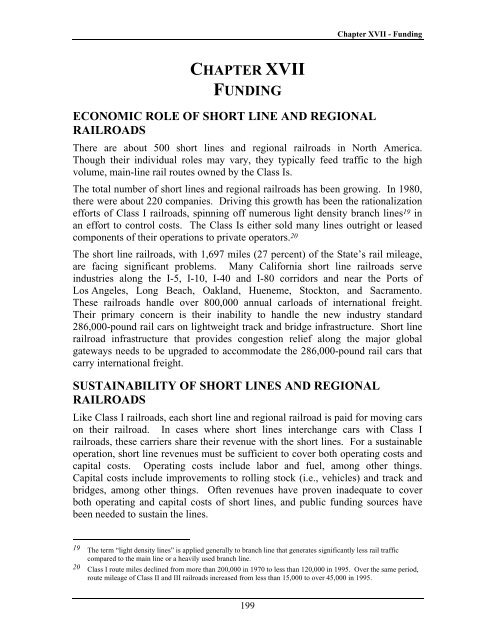California State Rail Plan 2005-06 to 2015-16
California State Rail Plan 2005-06 to 2015-16
California State Rail Plan 2005-06 to 2015-16
You also want an ePaper? Increase the reach of your titles
YUMPU automatically turns print PDFs into web optimized ePapers that Google loves.
Chapter XVII - Funding<br />
CHAPTER XVII<br />
FUNDING<br />
ECONOMIC ROLE OF SHORT LINE AND REGIONAL<br />
RAILROADS<br />
There are about 500 short lines and regional railroads in North America.<br />
Though their individual roles may vary, they typically feed traffic <strong>to</strong> the high<br />
volume, main-line rail routes owned by the Class Is.<br />
The <strong>to</strong>tal number of short lines and regional railroads has been growing. In 1980,<br />
there were about 220 companies. Driving this growth has been the rationalization<br />
efforts of Class I railroads, spinning off numerous light density branch lines 19 in<br />
an effort <strong>to</strong> control costs. The Class Is either sold many lines outright or leased<br />
components of their operations <strong>to</strong> private opera<strong>to</strong>rs. 20<br />
The short line railroads, with 1,697 miles (27 percent) of the <strong>State</strong>’s rail mileage,<br />
are facing significant problems. Many <strong>California</strong> short line railroads serve<br />
industries along the I-5, I-10, I-40 and I-80 corridors and near the Ports of<br />
Los Angeles, Long Beach, Oakland, Hueneme, S<strong>to</strong>ck<strong>to</strong>n, and Sacramen<strong>to</strong>.<br />
These railroads handle over 800,000 annual carloads of international freight.<br />
Their primary concern is their inability <strong>to</strong> handle the new industry standard<br />
286,000-pound rail cars on lightweight track and bridge infrastructure. Short line<br />
railroad infrastructure that provides congestion relief along the major global<br />
gateways needs <strong>to</strong> be upgraded <strong>to</strong> accommodate the 286,000-pound rail cars that<br />
carry international freight.<br />
SUSTAINABILITY OF SHORT LINES AND REGIONAL<br />
RAILROADS<br />
Like Class I railroads, each short line and regional railroad is paid for moving cars<br />
on their railroad. In cases where short lines interchange cars with Class I<br />
railroads, these carriers share their revenue with the short lines. For a sustainable<br />
operation, short line revenues must be sufficient <strong>to</strong> cover both operating costs and<br />
capital costs. Operating costs include labor and fuel, among other things.<br />
Capital costs include improvements <strong>to</strong> rolling s<strong>to</strong>ck (i.e., vehicles) and track and<br />
bridges, among other things. Often revenues have proven inadequate <strong>to</strong> cover<br />
both operating and capital costs of short lines, and public funding sources have<br />
been needed <strong>to</strong> sustain the lines.<br />
19 The term “light density lines” is applied generally <strong>to</strong> branch line that generates significantly less rail traffic<br />
compared <strong>to</strong> the main line or a heavily used branch line.<br />
20 Class I route miles declined from more than 200,000 in 1970 <strong>to</strong> less than 120,000 in 1995. Over the same period,<br />
route mileage of Class II and III railroads increased from less than 15,000 <strong>to</strong> over 45,000 in 1995.<br />
199













